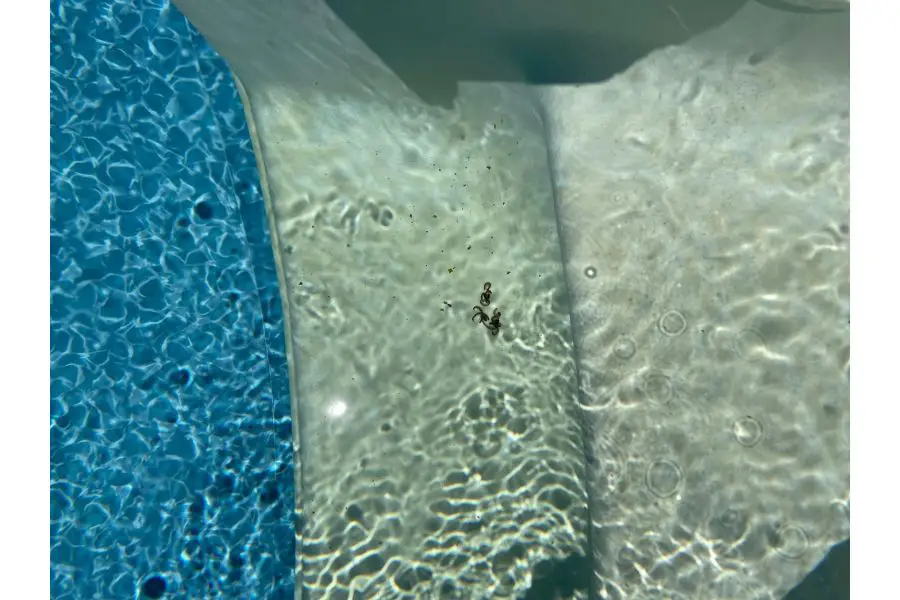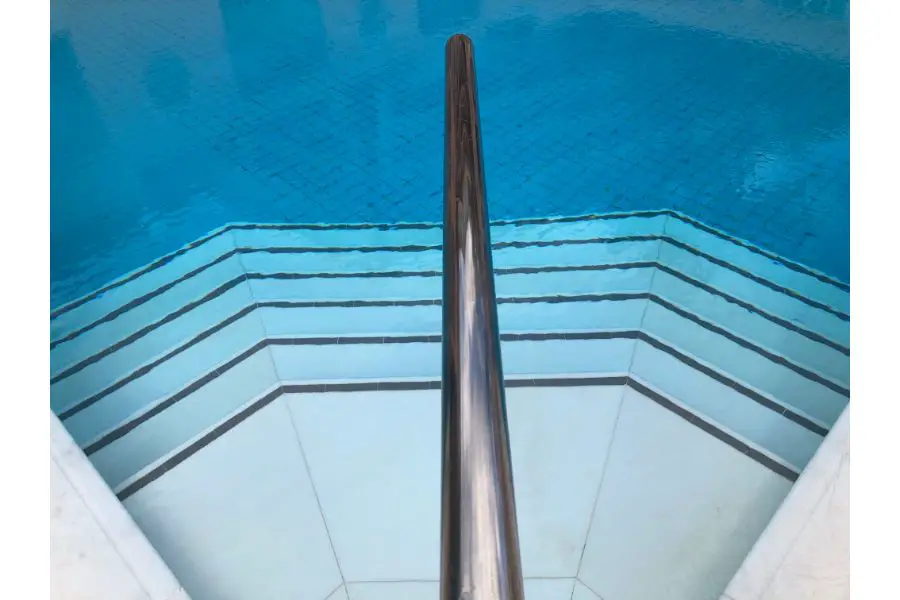Swimming in crystal clear water adds to the overall enjoyment. But, while clean water is important, it’s also essential to keep the surfaces in the pool clean –this includes the pool steps.
As time passes, pool steps can gather stains and change to an unsightly color. This may not only ruin the visual appeal, but could even be dangerous depending on the cause of the stains.
When determining how to clean the steps, the first thought may be to drain water from the pool. However, draining is not always practical, and actually has potential to damage certain types of pools, such as vinyl lined.
Similar to cleaning the liner, in most cases it is unnecessary to drain the pool in order to clean the steps.
In this post, we’ll look at how to clean pool steps underwater without draining. We’ll also assess what could be staining your steps, and how can you get them spick and span without draining the pool.
What Causes Stains on Pool Steps?
Pool stairs can get stained fairly easily, and they’re often overlooked in routine cleaning and maintenance. For vinyl pools, the steps are usually constructed of plastic or fiberglass, in which stains can stand out like a sore thumb.
Let’s take at the common culprits that could be behind the unsightly discoloration.
Organic Stains
When algae, mulch, seeds, or leaves fall into the pool steps and settle there, they could result in organic stains.
If the pool hasn’t been attended to for a while or if there was debris left during the winterization process, it’s likely that you’ll find some staining. These stains may have a brown or green color.
Organic stains are often the easiest to get rid of.
Mineral Stains
When the calcium in water breaks out from the solution form and mingles with oils and dirt, it can cause gray or brown discoloration to the steps when it deposits back onto them.
Mineral staining is more prevalent if you use hard water (high in calcium) when filling the pool.
Metal Stains
This occurs when metals in the water are oxidized by chlorine. Iron causes brown or orange hues, magnesium causes black ones, and cobalt causes blue ones.
Metals may be introduced into the pool from the water supply, or even from surrounding objects such as water features, decking materials, and pool chemicals. In other words, it’s nearly impossible to fully prevent some level of metals from entering the water.
Insect or Animal Stains
Insects and animals are organic in nature, and can pose similar risk of staining as leaves or other debris.
Depending on the environment around the pool, you may frequently find bugs in the pool. Many are likely to accumulate in the skimmer, but some will fall to the bottom of the stairs.
For instance, worms tend to sink fairly quickly before they can ever reach the skimmer. They may ultimately rest on the edges of the steps and cause staining over time.

How Do I Get My Pool Steps White Again?
Of all the colors your pool steps could be, white is perhaps the most prone to staining. Or, to be more accurate, stains on white steps would be a lot more visible than other colors.
This is why routine cleaning of the stairs needs to be thorough. In most cases, it’s best to keep the water in the pool during cleaning of the steps.
Here are some tips and tricks to help you out:
1 – Remove the Debris with a Pool Vacuum
Before you tackle the discoloration, start by removing all the visible dirt, leaves, and debris stuck to the steps.
Usually, the fastest and most hassle-free way to do this is using a pool vacuum or by using a pool brush.
2 – Sprinkle and Scrub Chlorine
Many organic stains can be removed almost instantaneously using chlorine. However, simply throwing chlorine granules in could blemish the liner.
So, what you want to do is sprinkle chlorine on the area. You can also use a PVC pipe filled with chlorine and move it in slow motion over the areas with stains to make sure the chlorine granules hit that exact spot.
Ideally, the pipe should measure two inches in diameter. This way, it won’t be too tight that the chlorine granules won’t come out or too wide that they’d spread haphazardly.
Then you can use a pool brush with a telescopic pole to scrub the steps, paying particular attention to the corners.
3 – Use Shock Treatments to Remove Organic Stains
Using high concentrations of chlorine in pool water is a process known as shocking, and it could help tackle stains in general.
Here’s the best practice for it:
- Measure the pH level and make sure it’s 7.2 to boost the efficiency of the treatment.
- Make sure to read the instructions on the chlorine you’re adding to the pool, as some require dilution. Otherwise, undiluted chlorine granules might cause damage to the surface of the pool.
- Ensure the pump is running, and then add the necessary quantity of shock based on the size of the pool.
- Distribute the shock by brushing the pool. This also helps in removing any film or layers of dust on the surface that keep contaminants around.
- Wait about 12 hours before retesting the pool to ensure chlorine concentration has returned to safe level for swimming.
After shocking the pool, you may need to follow up with backwashing, vacuuming, and brushing.
4 – Try Acid Treatments for Metal Stains
Ascorbic acid (Vitamin C) can be used to remove iron-based pool stains. Citric acid may be more effective for copper-based stains.
If you’re looking to remove metal staining from a relatively small section of the steps, you can simply sprinkle the acid into the water and swirl it around with a pool brush. It shouldn’t take long to see the stains lift and the steps return to their original color.
For a more focused cleaning, you can also place the dry acid powder into a sock, and then scrub the stairs with it. The acid will slowly release from the sock directly onto the area that you want to remove stains.
Lastly, if you have widespread staining that encompasses more than just the stairs, you may need to consider a full blown acid treatment of the pool. To do so:
- Ensure that the pH and alkalinity levels are balanced. Moreover, make sure to lower the chlorine levels to near 0 ppm to avoid clashing with the acid.
- Add ascorbic acid powder to the pool at a ratio of half a pound for every 10 thousand gallons of water.
- Turn the pool pump for at least 12 hours to allow circulation of the acid.
- If you still find residual stains, you can repeat the steps until all of them vanish. Or, you can tackle more concentrated stains by directly applying the acid.
- Retest the pool water to adjust the pH and alkalinity levels when you’re done.
To keep metal stains from returning, consider using a sequestering agent. This will help keep the metals from precipitating back onto the surfaces.
It’s worth mentioning that lowering the chlorine levels might increase the risk of algae growth. Consider adding some algaecide during the process.
5 – Tackle Stubborn Stains with Sponge Cleaning
If general water treatments don’t give you immediate results, you can try using a telescopic pole with a sponge or a stiff brush to scrub crushed ascorbic acid or even a store-bought enzyme cleaner.
This could work best for smaller stains since you’ll focus the cleaning action on that area only.
6 – Removing Calcium from Pool Steps
Calcium deposits can be tough to remove. If you have concrete or tile stairs, you may find success in using a pumice stone to scrub the calcium off.
However, if you have fiberglass or plastic steps, a pumice stone could cause scratches or damage. Often times a descaler product is your best bet. The descaler can be used to treat the entire pool rather than just a local area and may also help with certain metal stains.
Final Takeaway
You don’t have to fully drain a pool in order to clean it or remove stains, which is a huge relief.
Figuring out how to clean pool steps underwater is all about understanding what’s causing the stain to be able to pick the right remedy. You may find success in mixing multiple options together to keep those stairs looking brand new!
If you’re adding chemicals, such as shock, take the time to verify proper water balance before swimming again. It’s often best to start treatments after sunset, so that you don’t lose much swim-time during the warm summer days.
Happy Swimming!
Husband and father of three (actually, four if you include the pool). I’m an avid DIY-er and weekend warrior that enjoys taking up new projects around the house to help us maximize leisure right at home. I enjoy researching and sharing various tips, tricks and knowledge to help others make their home an oasis.

